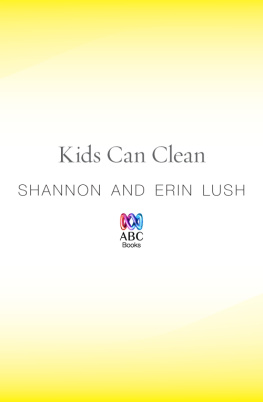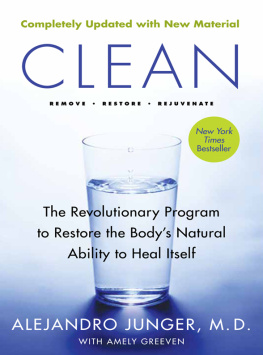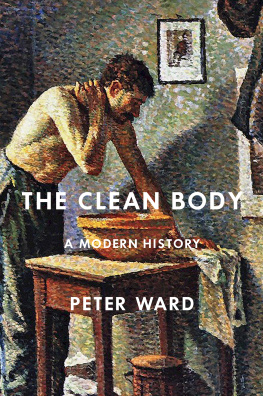Full of acute perceptions [an] exceptionally enjoyable book John Carey, Sunday Times
A terrific history of personal hygiene, a wonderfully interesting and amusing book Daily Mail
An entertaining tale of changing attitudes to cleanliness Guardian
This is perhaps the final irony in this splendid exercise in cultural relativism: that we can be too clean Tablet
Ashenburg is a lively and entertaining guide this is a sparkling, discursive and witty history: good, clean fun Cressida Connolly, New Statesman
A lively history of personal hygiene Isabel Berwick, Financial Times Magazine
Ashenburgs masterful mix of erudition and anecdote makes this a fascinating, fast-paced read More than just a witty insight into washing, her book confronts our obsession with preening, plucking and perfuming our bodies so that we smell less like humans and more like exotic fruits Thought-provoking and charming, this is a memorable read Time Out
Amazing factoids abound in this charming history of personal hygiene Tatler
Meticulous tome on the history of personal hygiene Esquire
Fascinating and entertaining Country Life
KATHERINE ASHENBURG has worked as an academic, a CBC Radio producer and the Arts and Books editor of the Toronto Globe and Mail. She has written for the New York Times and her books include The Mourners Dance: What We Do When People Die. She lives in Toronto.
Also by Katherine Ashenburg
GOING TO TOWN: ARCHITECTURAL WALKING
TOURS IN SOUTHERN ONTARIO
THE MOURNERS DANCE: WHAT WE DO
WHEN PEOPLE DIE

CLEAN
An
UNSANITIZED
HISTORY OF WASHING
KATHERINE
ASHENBURG

This paperback edition published in 2009
First published in Great Britain in 2008 by
PROFILE BOOKS LTD
3A Exmouth House
Pine Street
London EC1R 0JH
www.profilebooks.com
First published in Canada in 2007 by
Alfred A. Knopf
Copyright Katherine Ashenburg, 2008
Text design by Kelly Hill
1 3 5 7 9 10 8 6 4 2
Printed and bound in Great Britain by
CPI Bookmarque, Croydon, CRO 4TD
The moral right of the author has been asserted.
All rights reserved. Without limiting the rights under copyright reserved above, no part of this publication may be reproduced, stored or introduced into a retrieval system, or transmitted, in any form or by any means (electronic, mechanical, photocopying, recording or otherwise), without the prior written permission of both the copyright owner and the publisher of this book.
A CIP catalogue record for this book is available from the British Library.
ISBN 978 1 84668 101 1

For Kate and John,
who love their bath,
and for Alberto,
always immaculate

CONTENTS
ONE
The Social Bath: Greeks and Romans
TWO
Bathed in Christ: 2001000
THREE
A Steamy Interlude: 10001550
FOUR
A Passion for Clean Linen: 15501750
FIVE
The Return of Water: 17501815
SIX
Baths and How to Take Them: Europe, 18151900
SEVEN
Wet All Over at Once: America, 18151900
EIGHT
Soap Opera: 19001950
NINE
The Household Shrine: 1950 to the Present


BUT DIDNT THEY SMELL?
For the modern, middle-class North American, clean means that you shower and apply deodorant each and every day without fail. For the aristocratic seventeenth-century Frenchman, it meant that he changed his linen shirt daily and dabbled his hands in water but never touched the rest of his body with water or soap. For the Roman in the first century, it involved two or more hours of splashing, soaking and steaming the body in water of various temperatures, raking off sweat and oil with a metal scraper, and giving himself a final oilingall done daily, in company and without soap.
Even more than in the eye or the nose, cleanliness exists in the mind of the beholder. Every culture defines it for itself, choosing what it sees as the perfect point between squalid and over-fastidious. The modern North American, the seventeenth-century Frenchman and the Roman were each convinced that cleanliness was an important marker of civility and that his way was the royal road to a properly groomed body.
It follows that hygiene has always been a convenient stick with which to beat other peoples, who never seem to get it right. The outsiders usually err on the side of dirtiness. The ancient Egyptians thought that sitting a dusty body in still water, as the Greeks did, was a foul idea. Late-nineteenth-century Americans were scandalized by the dirtiness of Europeans; the Nazis promoted the idea of Jewish uncleanliness. At least since the Middle Ages, European travellers have enjoyed nominating the continents grubbiest countrythe laurels usually went to France or Spain. Sometimes the other is, suspiciously, too cleanwhich is how the Muslims, who scoured their bodies and washed their genitals, struck Europeans for centuries. The Muslims returned the compliment, regarding Europeans as downright filthy.
Most modern people have a sense that not much washing was done until the twentieth century, and the question I was asked most often while writing this book always came with a look of barely contained disgust: But didnt they smell? As St. Bernard said, where all stink, no one smells. The scent of one anothers bodies was the ocean our ancestors swam in, and they were used to the everyday odour of dried sweat. It was part of their world, along with the smells of cooking, roses, garbage, pine forests and manure. Twenty years ago, airplanes, restaurants, hotel rooms and most other public indoor spaces were thick with cigarette smoke. Most of us never noticed it. Now that these places are usually smoke-free, we shrink back affronted when we enter a room where someone has been smoking. The nose is adaptable, and teachable.
The North American reader, schooled on advertisements for soap and deodorants, is likely to protest at this point: But body odour is different from smoke. Body odour is innately disgusting. My own experience tells me that isnt true. For the first seven years of my life, I spent countless hours with my maternal grandmother, who came from Germany. She lived only a few houses down the street from us in Rochester, New York, and she often took care of us grandchildren. She was a cheerful, hard-working woman, perpetually cooking, cleaning, sewing, crocheting or knitting. Two smells bring my grandmother vividly to mind. One is the warm amalgam of yeast and linen, from the breads she shrouded in tea towels and set to rise on her dining-room radiators. The other smell came from my grandmother herself. As a child, it never occurred to me to describe it or wonder what it wasit was just part of my grandmother. Whom I loved, so the smell never troubled me.
Next page












